MXA RACE TEST: THE REAL TEST OF THE 2020 HONDA CRF450
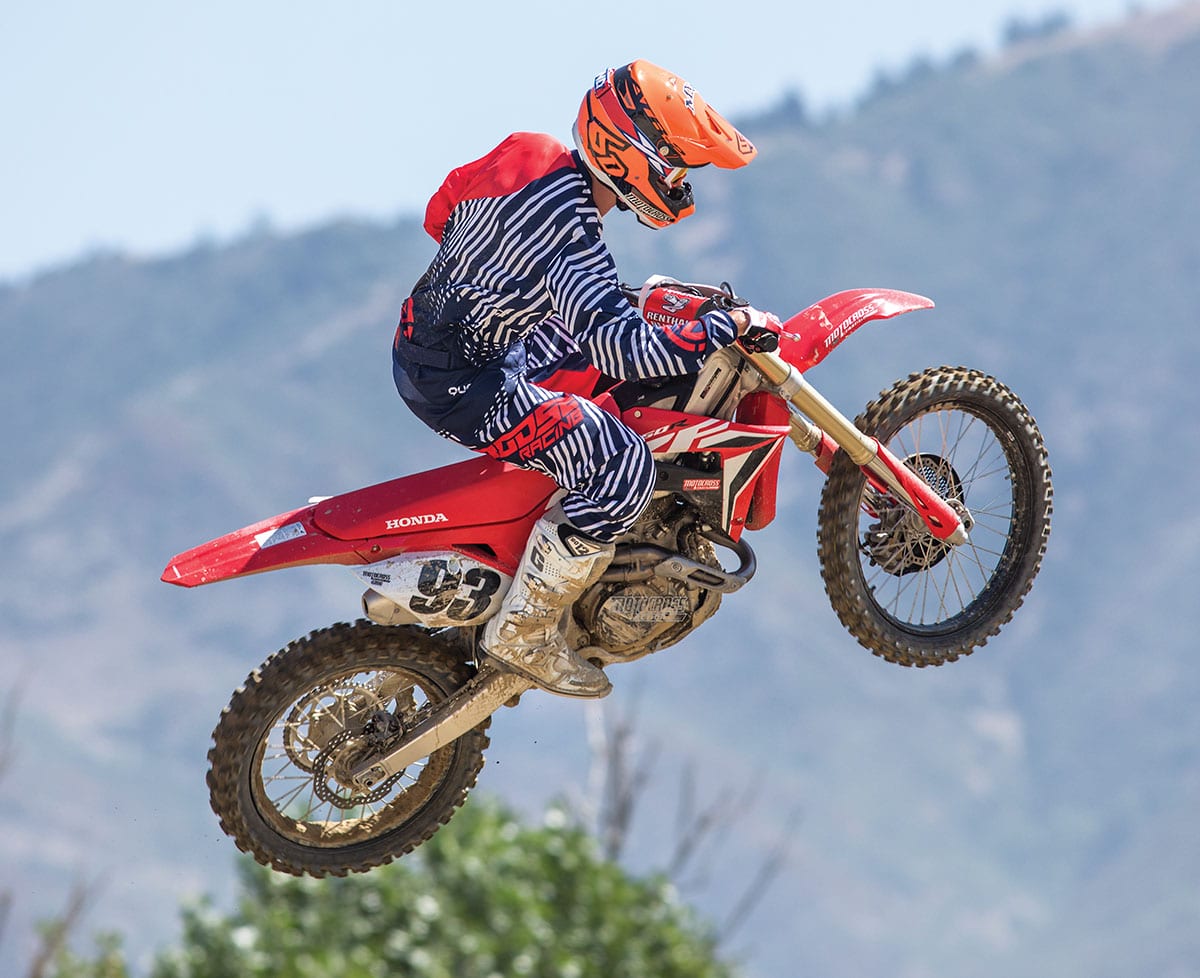
MXA RACE TEST: THE REAL TEST OF THE 2020 HONDA CRF450
Q: FIRST AND FOREMOST, IS THE 2020 CRF450 BETTER THAN THE 2019 CRF450?
A: Better is a relative term. It has a better all-around powerband for a racer looking for the ultimate peak power, but the chassis and the suspension are no better than they were last year. To understand how Honda got where it is in 2020, we need to explain the year-by-year updates that Honda has made to the CRF450 since 2017. Here is the list.
Q: WHAT CHANGES DID HONDA MAKE BETWEEN 2016 AND 2017?
A: The 2017 chassis was designed to undo the “cab forward” concept that held sway from 2009 to 2016. The 2017 differed from the 2016 in seven major ways.
(1) Front wheel. The 2017 front wheel is moved forward 13.1mm (farther in front of the engine).
(2) Swingarm. The 2017 swingarm was shortened to move the rear axle 23mm closer to the engine.
(3) Wheelbase. The 2017 wheelbase was decreased by 7mm.
(4) Head angle. The 2017 head angle was slackened to 27.22 degrees.
(5) Fork offset. The 2017 fork offset was returned to 22mm.
(6) Trail. The 2017 trail was increased from 4.3 inches to 4.6 inches.
(7) HPSD. For 2017, the HPSD steering damper was dropped (although the mounting points remain). In essence, the 2017 Honda CRF450 frame geometry had more in common with the 2008 numbers than the CRF450 from 2009 to 2016. 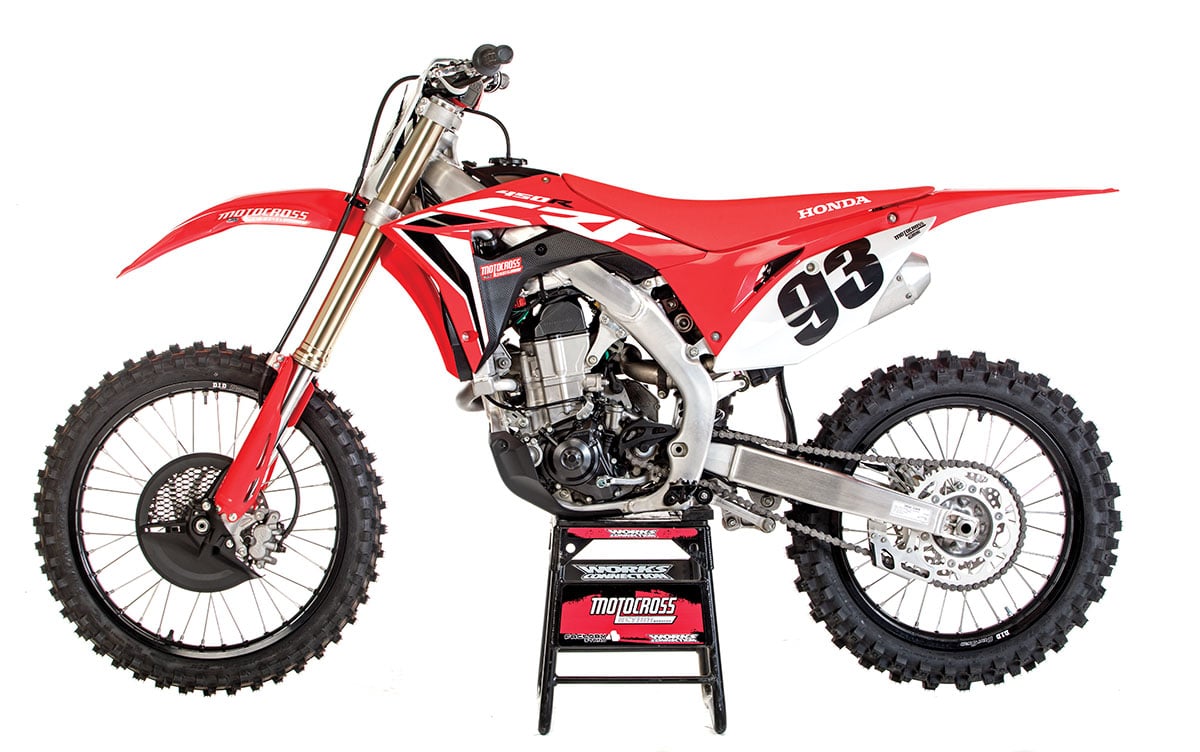
Incredibly attractive and ergonomically perfect, the 2020 CRF450 is a thing of beauty.
Q: WHAT CHANGES DID HONDA MAKE BETWEEN 2017 AND 2018?
A: No one expected Honda’s engineers to make any changes to the 2018 model since it was all-new in 2017, but they did make four changes.
(1) Electric starting. Electric starting became a cause celebre for the “Big Four” Japanese brands in 2018. Honda and Yamaha jumped onboard the “Better Living Through Electricity” train even though neither one of them could afford the 5-pound weight penalty that came with electric starting. In the Honda’s case, the 2018 CRF450 weighed 238 pounds. In 2017, it weighed 233 pounds.
(2) Mapping. In 2017, Honda CRF450 riders had issues with the stock mapping on the CRF450. For 2018, Honda downloaded a new map into the ECU. It lessened the herky-jerky low-end throttle response and cleaned up the low-to-mid transition.
(3) Suspension. In-the-know 2017 Honda CRF450 racers upped the spring rates on the Showa forks from 0.48 N/mm to 0.50 N/mm and traded the stock 54 N/m shock spring for a firmer 56 N/mm spring. Honda followed suit on the 2018 model with those exact same spring rates front and rear.
(4) Head stays. For 2018, the CRF450 got thinner and flexier head stays. The head stays were narrowed to feed a more resilient feel into the aluminum chassis.
Q: WHAT CHANGES DID HONDA MAKE BETWEEN 2018 AND 2019?
A: By 2019, Honda’s R&D department realized that another warmed-over 2017 CRF450 wasn’t enough, so they made six major changes for 2019.
(1) Engine. The CRF450 got an updated cylinder head design and a new clutch lifter and pressure plate to maximize oil supply to the clutch plates. Honda also added two 12mm scavenger pumps instead of the previous single 16mm pump. The mister nozzle on the underside of the piston was changed to a five-nozzle configuration. The ECU shift sensor got different ignition and fuel maps for each of the five gears. The engine cases were recast to eliminate the kickstarter boss.
(2) Horsepower. The 2019 Honda CRF450 produced 60.21 horsepower at peak. Although identical in power to the 2018 CRF450 from idle to 9000 rpm, above 9000 rpm, the 2019 made 3 horses more on top.
(3) Exhaust. The previous 31.8mm mid-pipes were increased in diameter to 35mm and 43mm. Total tuned length was 98mm on the right pipe and 187mm on the left pipe.
(4) Mapping. The three push-button maps were updated, and launch control was added (by offering three different rev-limiter settings).
(5) Suspension. The Showa coil-spring forks got new valving, wraparound fork guards and ultra-low-viscosity fork oil. The rear shock rode on a revised rising-rate shock linkage and a lighter and less-rigid swingarm.
(6) Brakes. The front brake caliper was equipped with one 30mm and one 27mm piston (instead of two 27mm pistons).
(7) Miscellaneous. Black anodized Renthal Fatbars were mounted 15mm lower on four-way adjustable bar mounts. The footpegs were 20-percent lighter.

Q: WHAT CHANGES DID HONDA MAKE BETWEEN 2019 AND 2020?
A: The 2020 Honda CRF450 is different from the 2019 model in five ways.
(1) Battery. The battery is moved 28mm lower in the airbox to improve centralization of mass and allow the air filter to get more direct airflow.
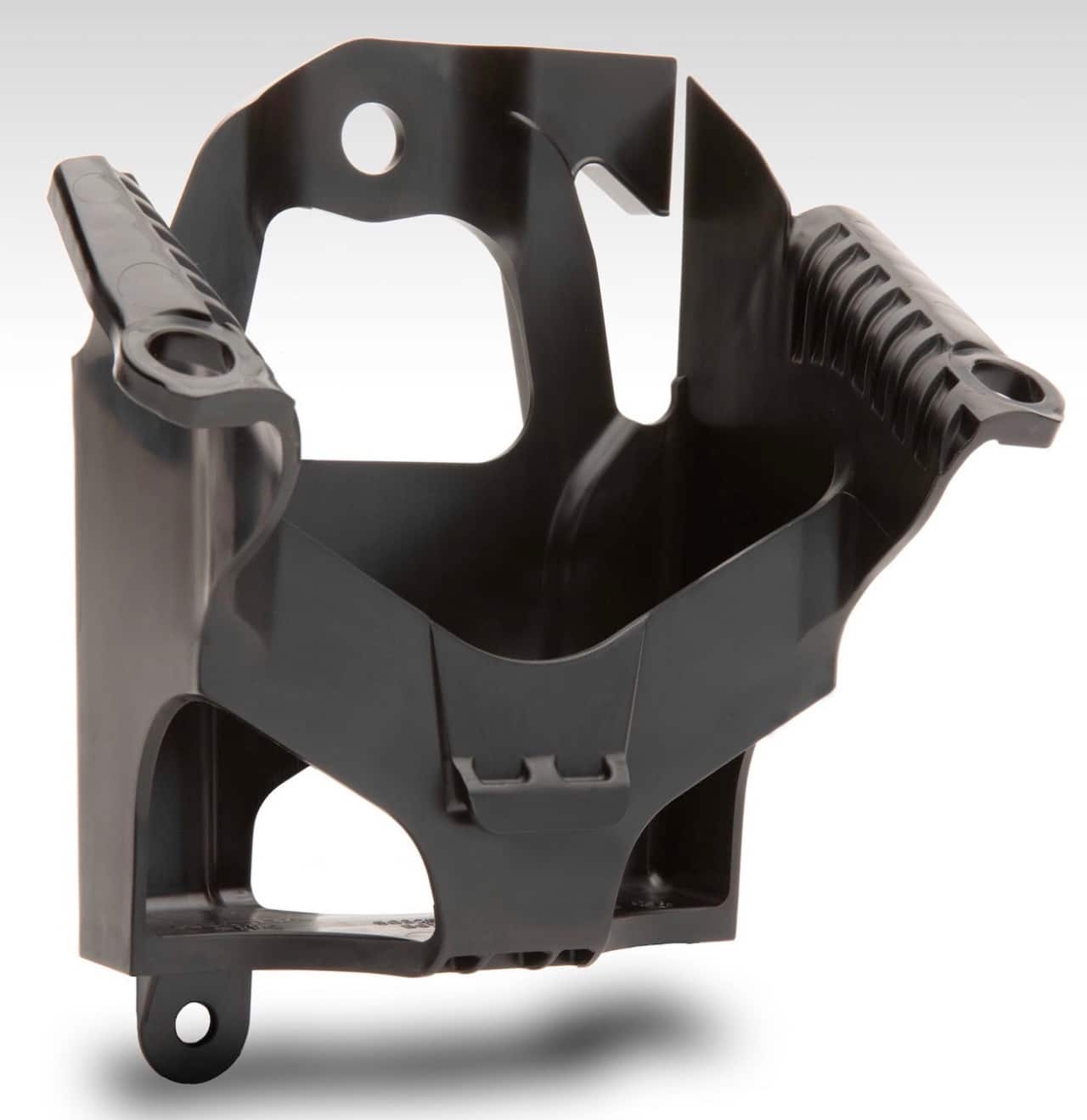
(2) Suspension. The Showa coil spring forks get revised valving to allow the forks to ride higher in their stroke.
(3) Maps. The CRF450’s electronics suite includes three different maps. Each mode produces a different style of power that is signaled by a blinking light—one flash is stock, two flashes is mellow, three flashes is aggressive.
(4) Traction and launch control. There are three different settings of traction control and three different rev-limiter metered launch-control settings (activated by the starter button) .
(5) Rear brake pads. The rear brake pad’s compound was borrowed from the ATV line for better grip and increased durability. Additionally, the rear brake rotor guard has been eliminated.
Q: WHAT CHANGES SHOULD HONDA MAKE BETWEEN 2020 AND 2021?
A: The MXA wrecking crew has no power over what Honda will change on the 2021 CRF450, but we know what we would change if we were in charge. Sadly, we have asked for these same eight changes every year, and we have never gotten what we wanted. Oh well, here is the list again.
(1) Weight. The 2020 Honda CRF450 weighs 238 pounds, which is exactly what it weighed in 2018 and 2019 (it weighed 233 pounds back in 2017 because it didn’t have electric starting). That is 15 pounds heavier than a 2020 KTM 450SXF.
(2) Twice pipes. The 2020 CRF450’s twice pipes carry a weight penalty that Honda can ill afford to ignore. Two mufflers, that are basically a fashion statement, make no sense on a bike that is already way too heavy.
(3) Titanium gas tank. Honda’s titanium gas tank is supposed to be a value-added upgrade, but if that is true, why is it virtually invisible underneath a plastic cover? Just give us a plastic gas tank or expose the Ti one.
(4) Radiator cap. When MXA’s 2020 CRF450 spews water out of the radiator overflow, we swap out the stock 1.1 kg/mm2 radiator cap for a 1.8 or 2.0 kg/cm2 radiator cap to raise the boiling point of the radiator fluid.
(5) Clutch. Honda has not had a durable clutch since 2008. To make matters worse, Honda’s clutch comes with the less-than-stellar judder spring system. We remove the judder spring, judder washer and down-sized fiber plate and replace them with one additional true-to-life fiber plate.
(6) Handling. We’d calm down the frame geometry more than the engineers did in 2017. Everybody likes a bike that turns in sharp, but nobody likes a bike that is exceedingly loose at speed. There is a happy medium.
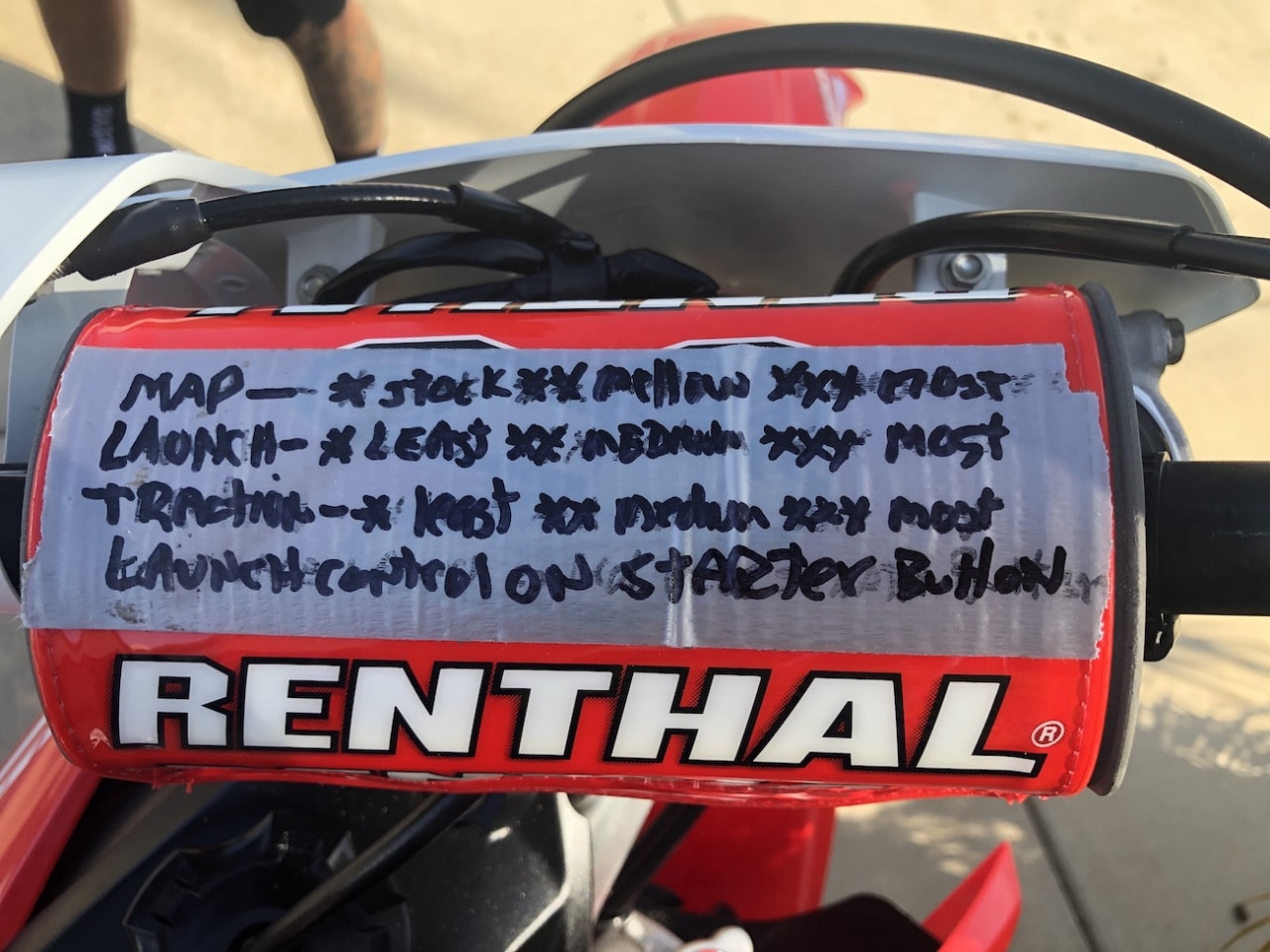 This is how we teach MXA test riders what each button does. Note the last line: “Launch Control on starter button.”
This is how we teach MXA test riders what each button does. Note the last line: “Launch Control on starter button.”
Q: IS THE 2020 CRF450 FASTER THAN THE 2019 CRF450?
A: No, but don’t get suicidal. The 2020 Honda CRF450 is still the most powerful 450 motocross bike on the track, but on the dyno the 2019 CRF450 actually made more horsepower and more torque at almost every step on the run-up to the 11,600 rpm sign-off. The 2019 CRF450 pumped out 60.21 peak at 9500 rpm, while the 2020 makes 59.74 at 9600 rpm. The torque numbers are even more favorable for last year’s engine. Given that the mechanical parts of both the 2019 and 2020 engines are identical, we guess that the difference is caused by new 2020 mapping.
Just so you know, the 2020 Honda CRF450 power advantage does not come to the front until 9600 rpm. Below that high-rpm peak, the KTM 450SXF is the king of horsepower (with the Husqvarna FC450 a close second). Down low, the 2020 Honda does not pull through to the midrange very smoothly. It’s not lazy, just stagey. It’s snappy, then calm, then revvy. But once you get to the midrange, it’s very strong. In any corner below walking speed, you can stay in third gear. And you want to be in third gear, because it helps the chassis and suspension more than the chassis and suspension can help themselves.
Even though the numbers don’t favor the 2020 CRF450 over the 2019 CRF450, it is actually a much better powerband—warts and all. Last year’s CRF450 powerband was kind of lumpy down low, but when it hit it rang the carny bell. In fact, it knocked the bell off the pole. This aggressive power was too much for most riders and way too much for Honda’s rigid and skittish chassis. The more temperate power delivery of the 2020 is easier to use, less scary in the rough and broader across the board. How does it do all of this if it makes less horsepower and less torque? It does it by putting the power in the ground thanks to an updated map. The faster 2019 powerband had a very poor relationship with the ground under its wheels; it couldn’t keep in constant contact. The 2020 engine is more manageable. This isn’t all the buttons you can push on a 2020 CRF450, but it’s more than enough.
This isn’t all the buttons you can push on a 2020 CRF450, but it’s more than enough.
Not every rider is interested in racing the most powerful bike made, either the 2019 or 2020 model. In these cases, we would advise slower test riders to choose their favorite map (one flash is stock, two flashes is mellow and three flashes is aggressive) and then engage the torque control (one flash is the aggressive torque control, two flashes is moderate torque control, three flashes is mellow torque control and no flash is no torque control). What does engaging the maps and traction control at the same time do? When you are riding the bike in your favorite map, it has no effect on the power delivery; but, when you spin the rear wheel on slippery, wet or bumpy ground, the torque control kicks in to help keep the rear wheel hooked up. Not surprisingly, your rear wheel does not only break loose in the obvious situations, so running traction control covers a lot of bases. Additionally, on the Honda, KTM and Husqvarna, some MXA test riders use traction control in lieu of launch control for starts.
Q: DOES THE 2020 CRF450 HANDLE BETTER THAN THE 2019 MODEL?
A: No. There are no frame geometry changes between the 2019 and 2020 CRF450. If there is any noticeable improvement in the very rigid Delta Box Honda chassis, it comes from the fact that the power delivery is toned down through the midrange. Make no mistake about it, the combination of the Honda’s high-horsepower, ultra-stiff frame and soft forks results in a Saint Christopher medal-worthy ride. The CRF450 is best at turn-in, where it can carve a tight inside line like it’s on a roller-coaster track, but as much as we liked the 2020 CRF450 on the entrance of turns, we were afraid, very afraid, when exiting a turn into choppy acceleration bumps. The rougher the track and the faster the rider, the more the frame was out of its element.
Strangely, every change we made to one end of the bike had a negative effect on the chassis’ stability. On tight twisty tracks with mellow bumps, the Honda felt great. Then two hours later for the second moto, it felt like it was possessed. We chased setup at every race only to have it feel good in moto one and terrible in moto two. This isn’t a new sensation for loyal Honda riders. They are experts at what to do when the rear end breaks loose on acceleration.
Q: HOW GOOD IS THE SUSPENSION?
A: Although the Showa forks have been re-valved to ride higher in their stroke and to feel firmer in the mid-stroke thanks to some attention paid to the cross-over shim, the forks are too soft. This helped in the small bumps, but the forks rode too low in their stroke, giving up the easy travel and bottoming metal to metal when landing from jumps. Most test riders went stiffer on the fork’s compression damping to stop the bottoming, but for average-speed riders that wasn’t a plus in mid-size bumps. The rigidity of the frame and stinkbug stance contribute to the fork issues, but since Showa re-valved the forks for 2020, we expected more improvement. We found that going up on the fork’s spring rate or having the compression shim stack re-valved could hold the forks up in their stroke and stop the bottoming.
We set the shock’s race sag at 107mm to balance out the chassis and used fork height to fight the tendency to head shake at speed. The CRF450 rear shock works well at low speed and in bump sizes that don’t stress it very much, but once you push the shock harder it will G-out on the backside of bumps, jumps and whoops. Worse yet, it exhibits a vicious kick in square-edge bumps.
Q: WHAT DID WE HATE?
A: The hate list:
(1) Clutch. Get rid of the judder spring and add a full-size friction plate. If you need to run stiffer clutch springs, use them sparingly, as going stiffer on every spring makes the clutch’s actuation window very small. We run three stiffer springs.
(2) Radiators. It boils water like a steam iron. We check it after every long moto. Switch to a high-pressure radiator cap. Additionally, inspect the radiator finning to make sure that it hasn’t been bent closed by roost.
(3) Exhaust. We have tested single-sided CRF450 exhausts that make more horsepower, so that can’t be the reason that Honda mounts its Rube Goldberg-designed twin mufflers on the CRF450.
(4) Handling. The perfect bike to ride on a turn track. Not the perfect bike to ride on a fast, rough and gnarly outdoor track.
(5) Weight. Honda can easily justify the CRF450 weighing 238 pounds because that is exactly what a 2020 YZ450F weighs. They never heard of KTM.
(6) Setup. This is the most difficult bike to set up, find balance or get dialed on. It is a very sensitive bike.
(7) Forks. The forks are too soft. They may be okay for Vets, but not Pros.
(8) Sound. On the 115-dB AMA and FIM 2-meter-max sound test, it blew 117.5 dB. That’s very loud; however, it did pass the 94-dB Amateur sound test.
(9) Electronics. Someone was bound to take mapping, traction control and launch control too far. We doubt that very many racers have the patience to try all the settings. Even the electric-starter button does double duty.
Q: WHAT DID WE LIKE?
A: The like list:
(1) Horsepower. Someone has to have the most horsepower—this is that someone. Someone has to have the best powerband—this isn’t that someone.
(2) Ergos. Nothing feels as nice, comfy and well laid-out as a CRF450.
(3) Electric starting. It works once you remember to pull the clutch lever in.
(4) Maps. We like adjustable maps, but in the CRF450’s case, most test riders stuck with the stock map. The aggressive map felt crisper but actually gave up 1 horse everywhere.
(5) Handlebars. The oversize Renthal FatBars are a nice touch.
(6) Gearing. The stock 13/49 gearing is in the ballpark. We wouldn’t gear it down, but some test riders liked a taller 13/48.
(7) Launch control. Honda’s launch control doesn’t retard the ignition timing like everybody else’s launch control; instead, it has three different rev-limiter settings.

Q: WHAT DO WE REALLY THINK?
A: The 2020 Honda CRF450 doesn’t obsolete the 2019 CRF. The engine is better in that it is more usable, but it’s nothing you couldn’t do to with ECU mapping. It’s a changed bike, but only the powerband is changed. The 2020 Honda CRF450 chassis, suspension and stability are no less suspect than last year.
MXA’S 2020 HONDA CRF450 SETUP SPECS
This is how we set up our 2020 Honda CRF450 for racing. We offer it as a guide to help you find your own sweet spot.

SHOWA COIL SPRING FORK SETTINGS
Our Pro test riders ran the compression on six clicks out and the rebound on 10 clicks out. Intermediate test riders ran both the compression and rebound on 12 clicks out. Vet and Novice test riders went with 13 clicks out on both clickers. For hardcore racing, these are MXA’s recommended 2020 CRF450 fork settings (stock settings are in parentheses):
Spring rate: 5.0 N/mm
Compression: 6 clicks out (Pro), 12 clicks out (Intermediates), 13 clicks out (Vets)
Rebound: 10 clicks out (12 clicks out stock)
Fork-leg height: Flush with stock fork (until you re-valve them)
Notes: Don’t be afraid to crank in on the compression clickers if you are looking for a suppler feel. Sometimes stiffer is softer. We had issues with a very harsh feel in small braking bumps and an overly soft feel on bigger bumps and jump landings. We could not iron it out with the clicks available to us. You have to experiment for your weight, speed and track conditions.
SHOWA SHOCK SETTINGS
We set the race sag at 107mm to lower the overall bike height while using fork leg height to balance out the frame geometry. Had we just lowered the rear, it would have kicked the head angle out and slackened the geometry. The 2020 CRF450 is very sensitive to fore/aft balance changes. Any change to the shock seriously affects the forks. We start with the low-speed compression at 10 clicks out and the rebound at seven clicks out. From there, we go out to make the shock softer for Vet riders. If the shock Gs out in dips and on jump landings, turn the high-speed compression dial in. The stock high-speed compression is 3 turns out. For hardcore racing, these are MXA’s recommended 2020 CRF450 shock settings:
Spring rate: 56 N/mm
Race sag: 107mm
Hi-compression: 2-3/4 turns out (3 turns out)
Lo-compression: 10 clicks out (9 clicks out)
Rebound: 7 clicks out (9 clicks out)
Notes: The goal with the Honda CRF450’s frame geometry. is to find some balance between the front and the back of the chassis. We prefer to run longer shock links to lower the rear end and stiffen the compression damping at the initial startup point. If you are light, switch back to 2017’s 5.4 N/mm spring. Try softening all the clickers on the 2019 shock by four clicks before buying a shock spring, but beware of the shock G-ing out. The clickers have a fairly significant impact on suspension feel.


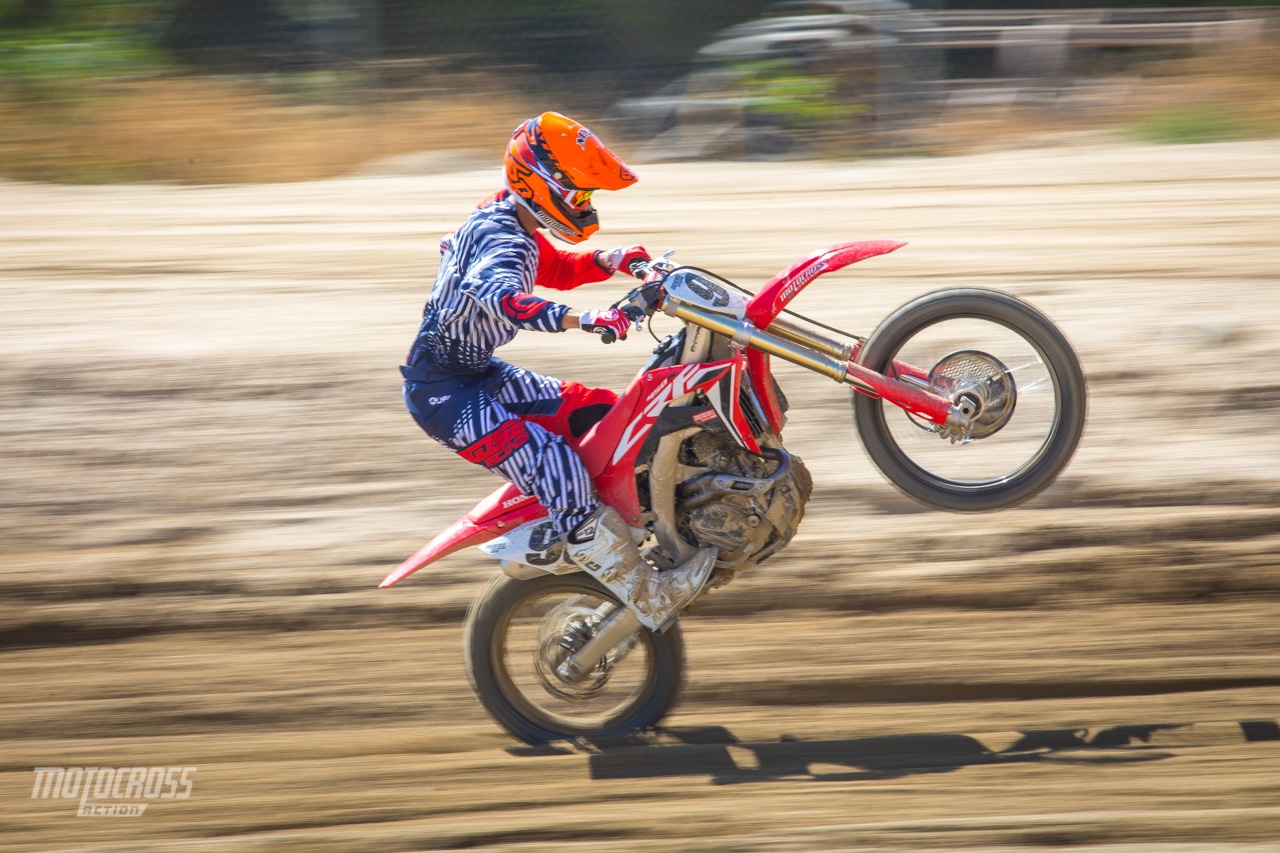
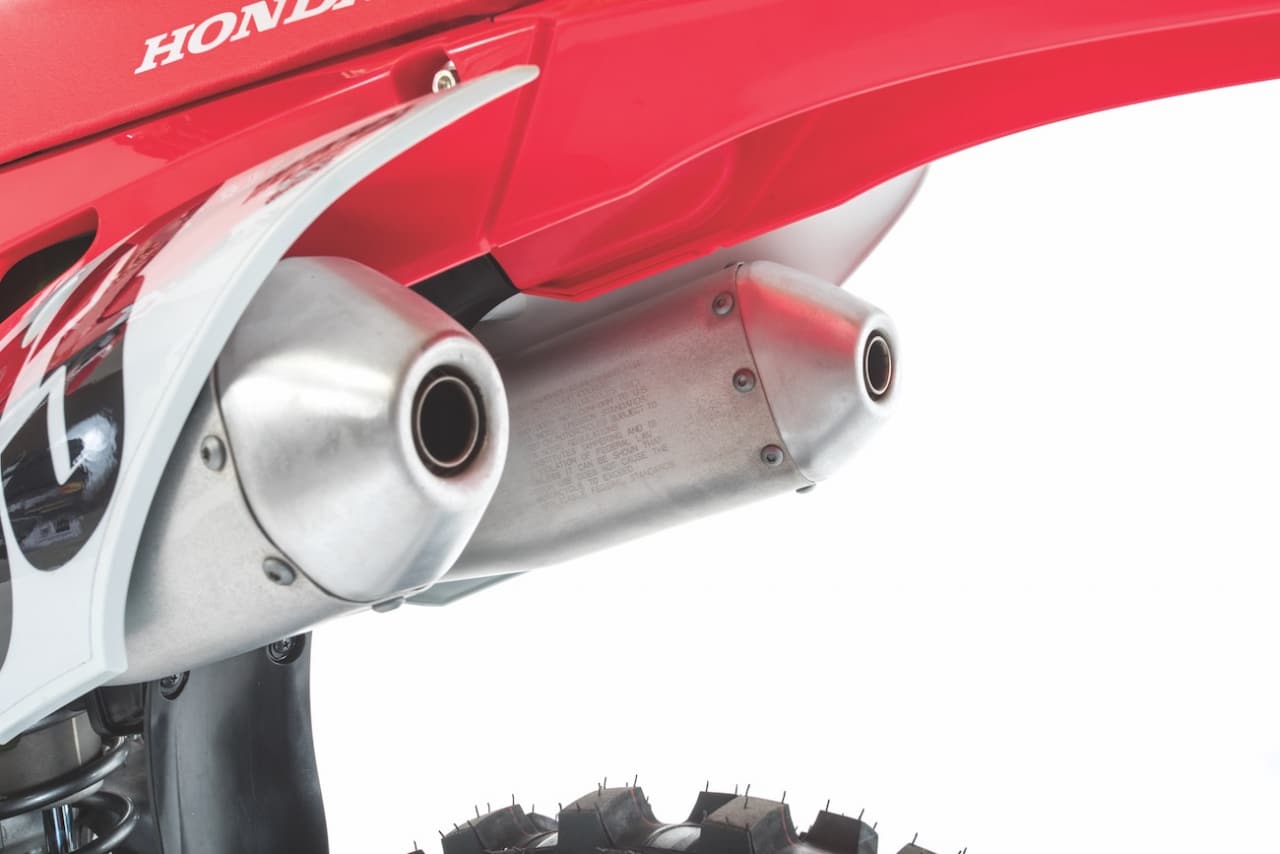
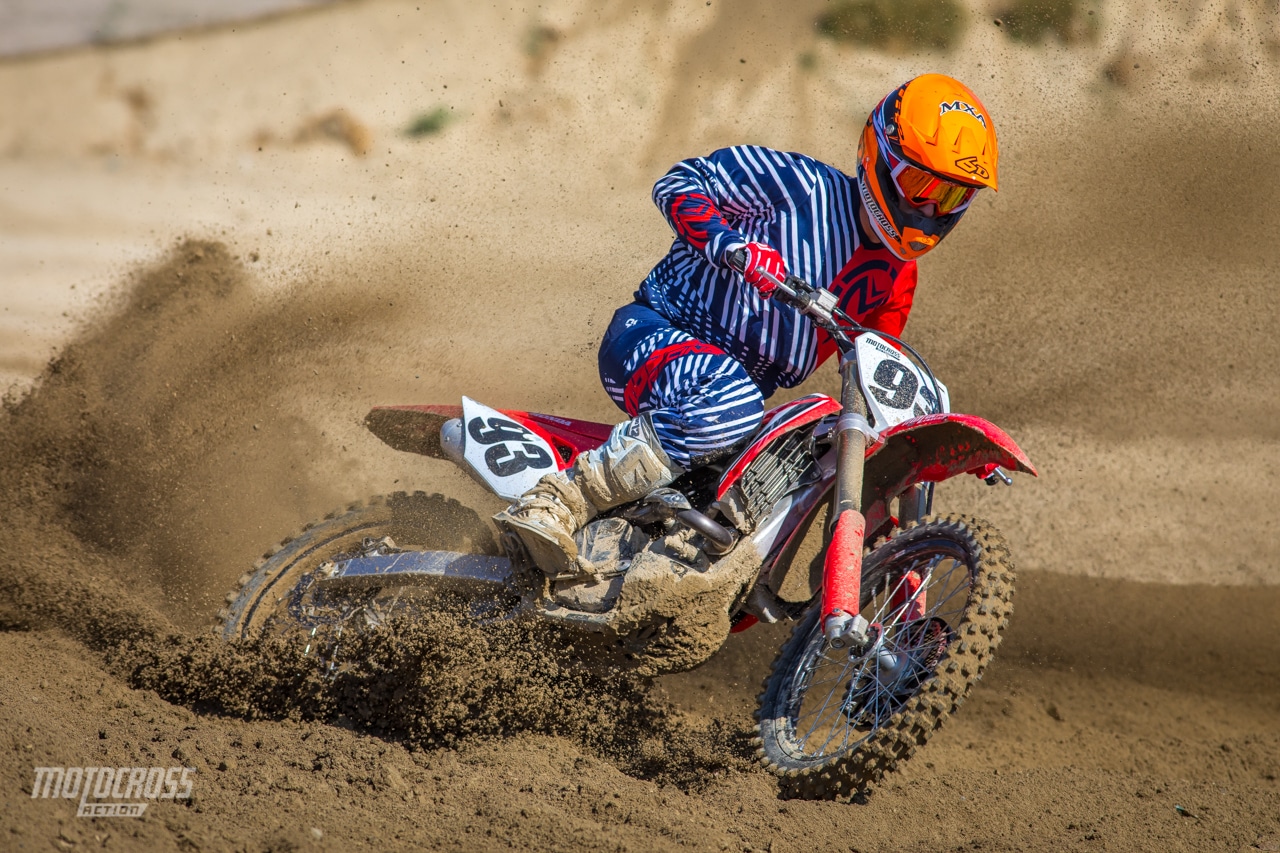

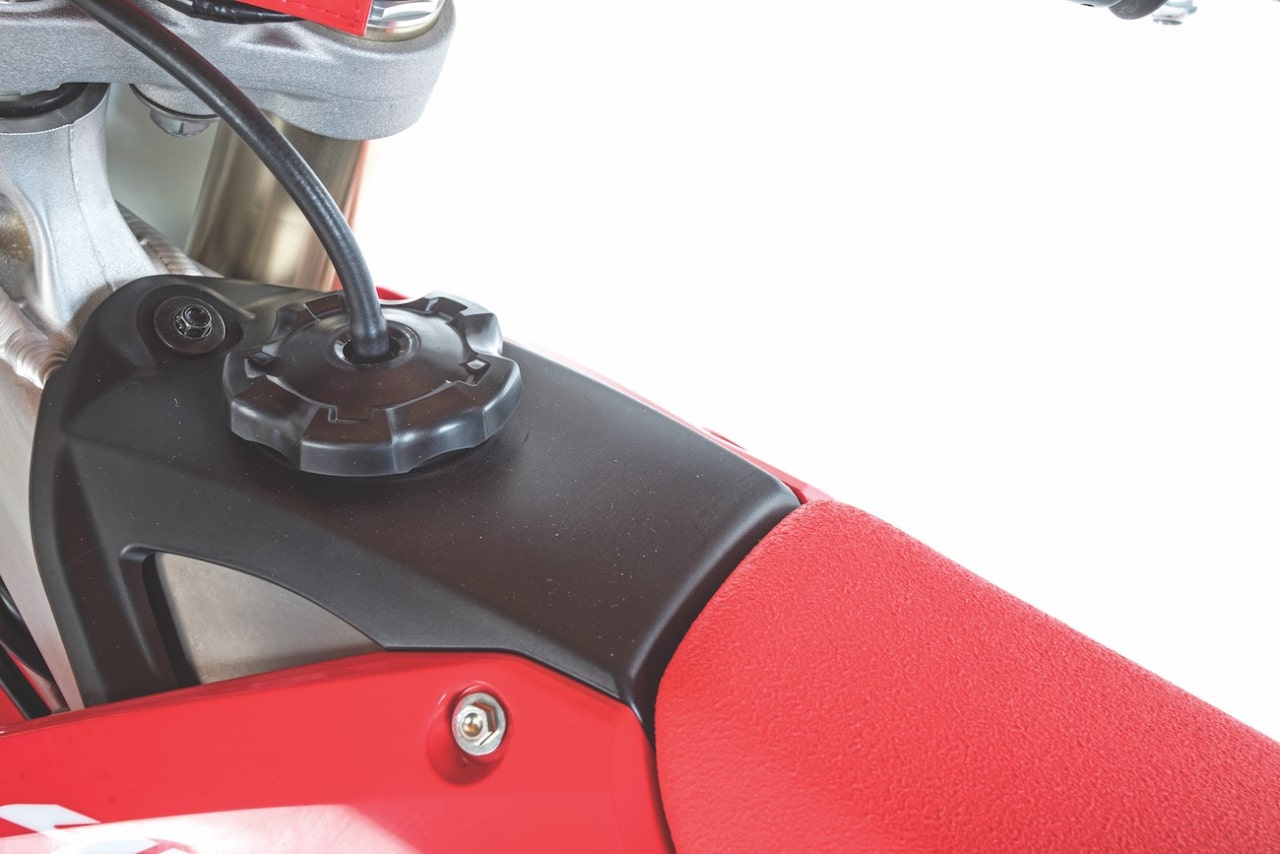

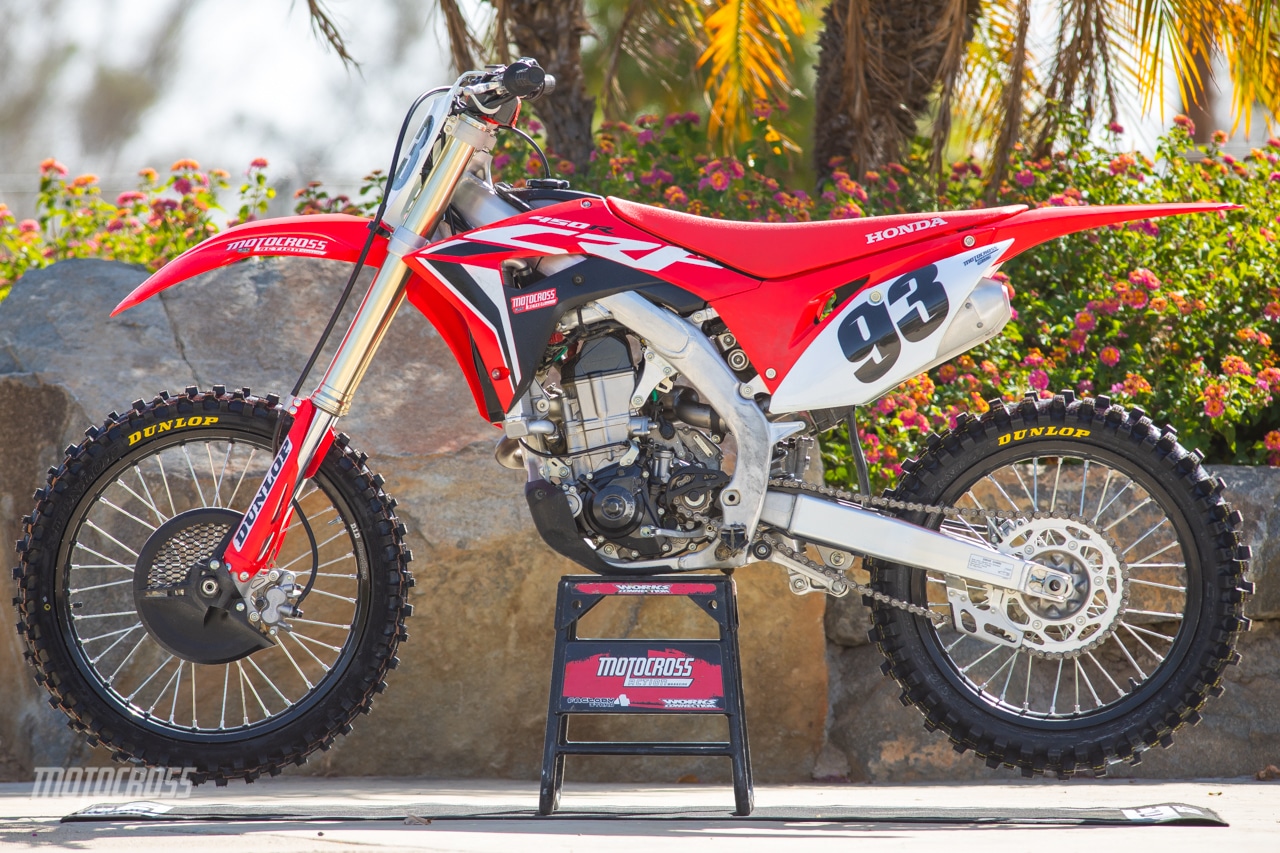
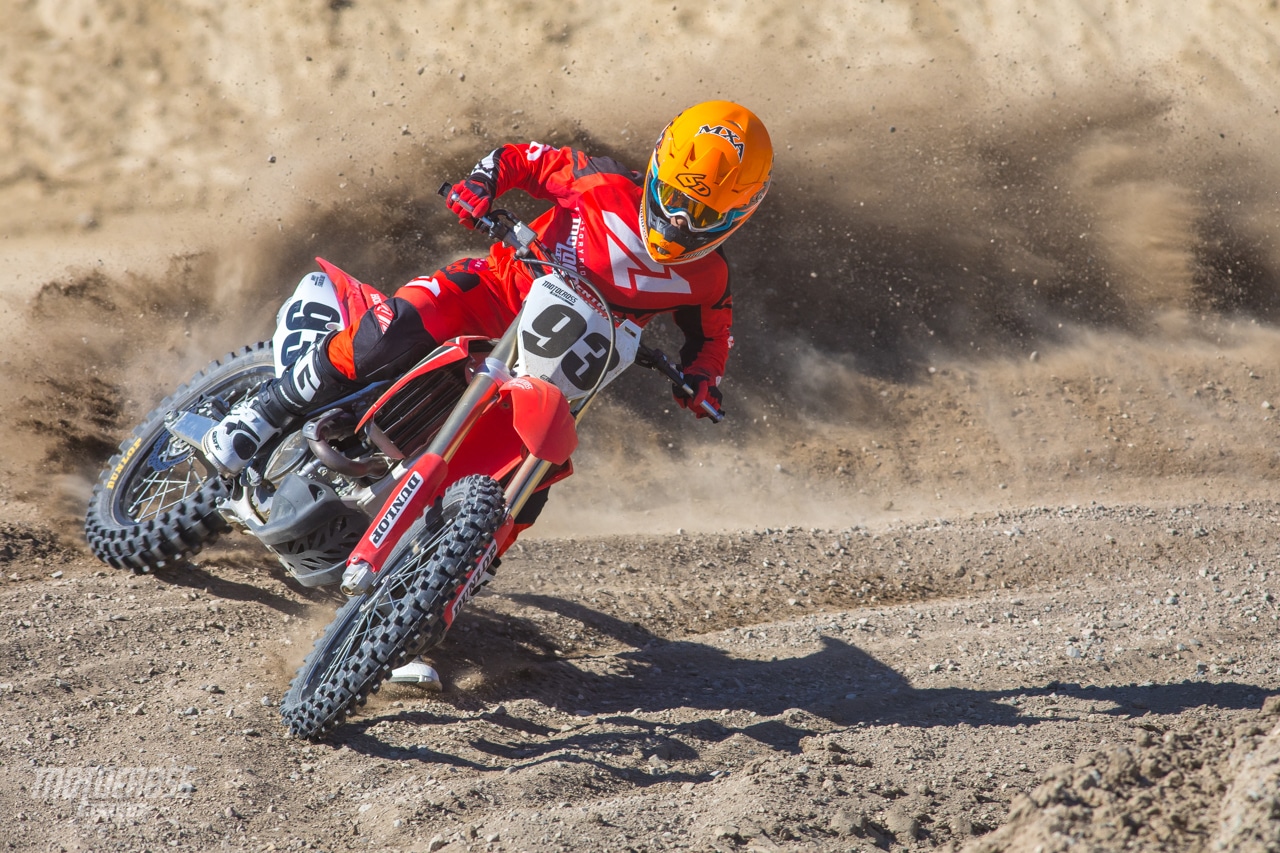
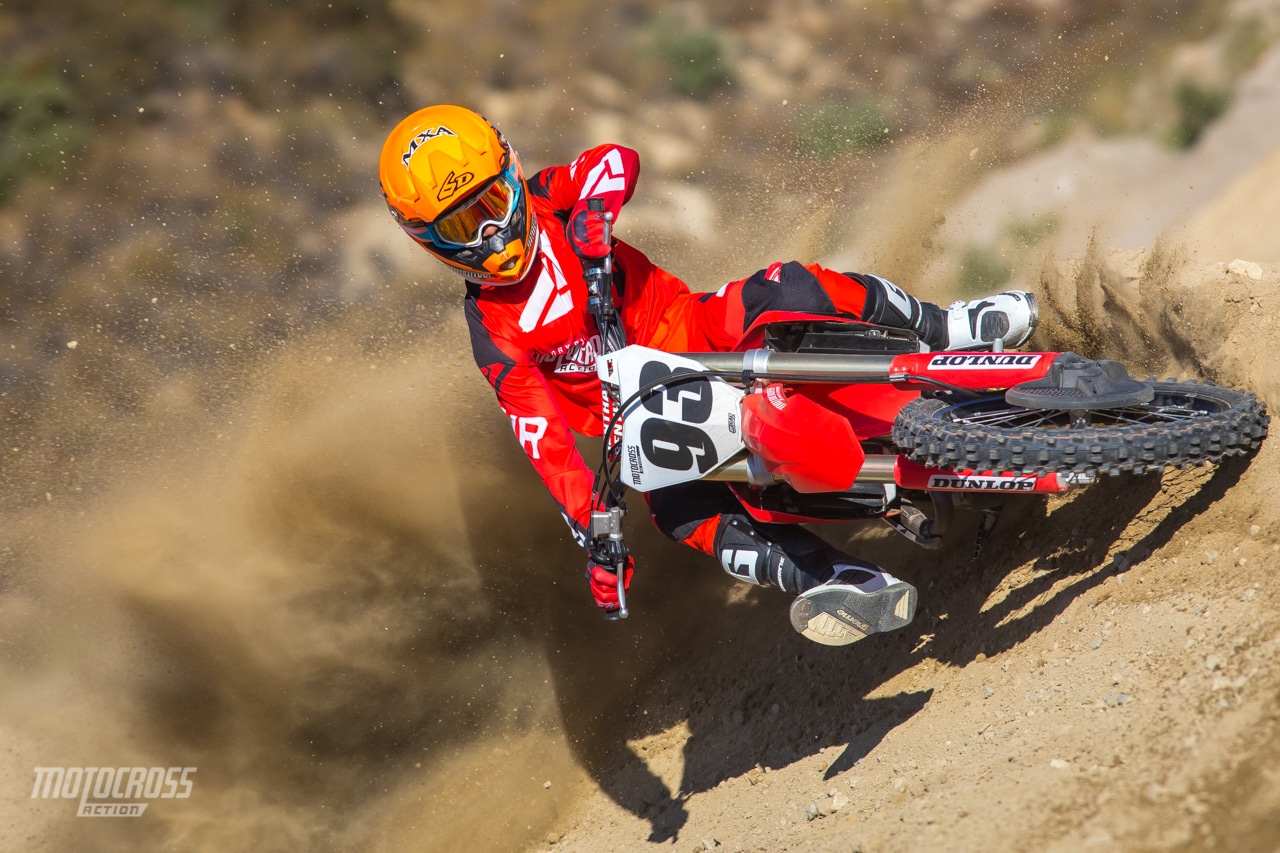

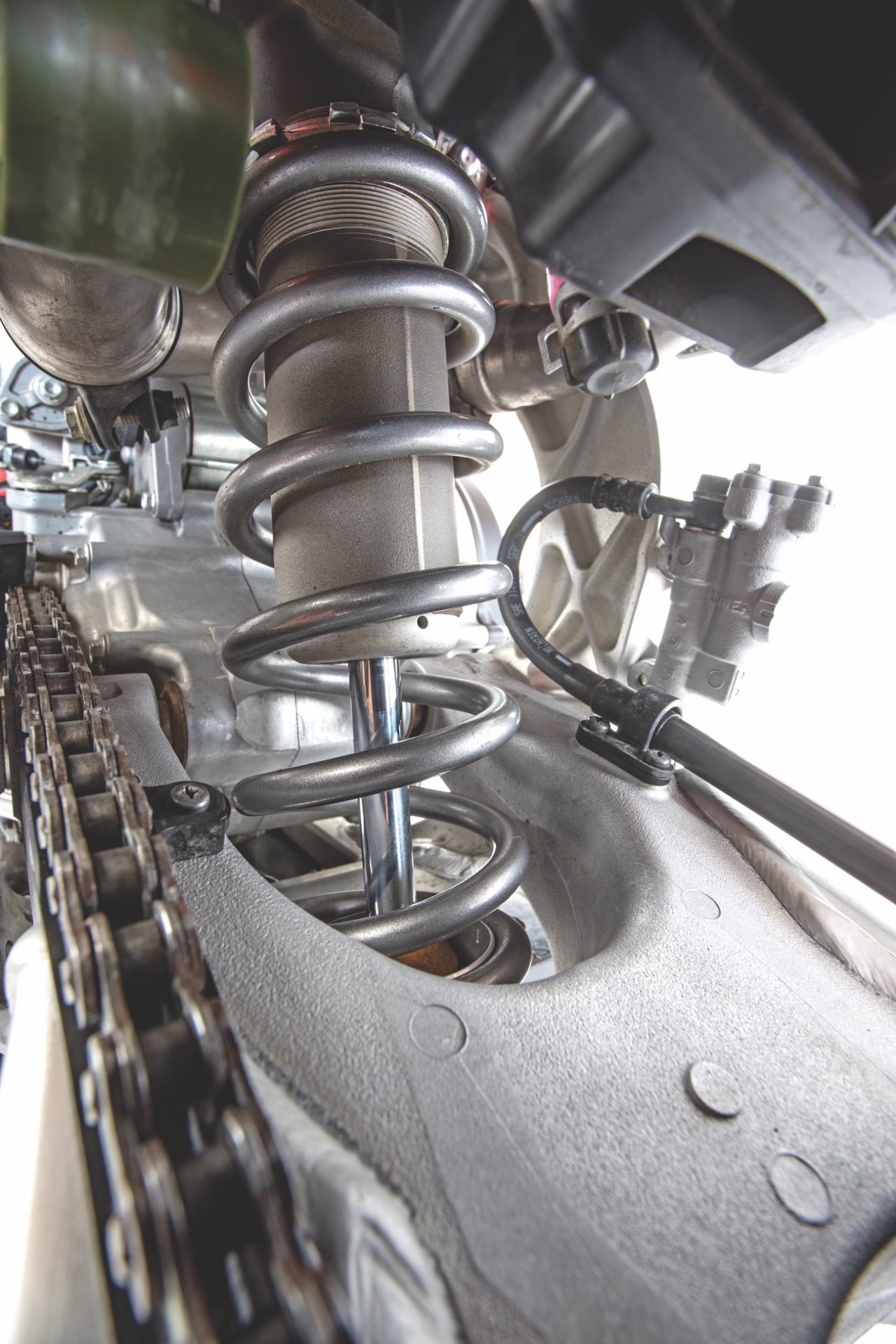



Comments are closed.